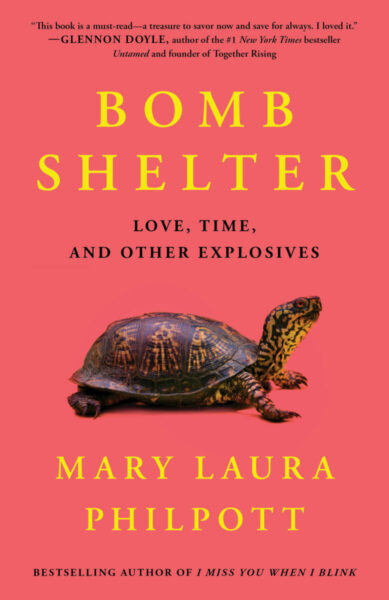Interview by Leslie Lindsay
 This “gorgeous, life-affirming, gut-wrenching” (Lori Gottlieb) memoir had me gasping—in a ‘she totally gets it’ way. Mary Laura Philpott brings to life the absurd, delightful, and profound. She is at once hilarious and resonate, a slip of what we all crave now: humanity.
This “gorgeous, life-affirming, gut-wrenching” (Lori Gottlieb) memoir had me gasping—in a ‘she totally gets it’ way. Mary Laura Philpott brings to life the absurd, delightful, and profound. She is at once hilarious and resonate, a slip of what we all crave now: humanity.
The big questions of life, death, existential fear, and hope—and more—are tidily summed up on this memoir-in-essays, which had me nodding in recognition, laughing, and crying, too.
Mary Laura Philpott has an uncanny ability to take the personal and spin it into a web of universality, which is no small feat. I was enthralled with her wry humor, her love for dogs, her family, and yes—even her axiety. She pulls you in with the mundane, but extrapolates and inserts you—the reader—smack into the middle of her unspooling thoughts.
The question she explores in sparkling, mosaic-like prose in Bomb Shelter: Love, Time, and Other Explosives (Simon and Schuster, April 12, 2022) is: how can any of us keep going when we can’t know for sure what is coming next?
This is a book for anyone—anytime—but it’s clearly written by a passionate and friendly writer-at-heart,
“Assigning meaning to events is so satisfying. I want themes, threads, a plot that begins with a question and then proceeds to a resolution. I want people to learn their lessons and change their ways and for the moral of the story to make us a better species.”
Leave it to a writer whose critically acclaimed debut had readers “laughing and crying on the same page,” (NPR) to illuminate what it means to move through life with a soul made of equal parts anxiety and optimism—and to remind us that although there is no shelter from the bomb of loss, love is never pointless. And also—what do turtles have to do with it?
Today I was able to chat with Mary Laura via email about all of these things, but specifically we spoke candidly about motherhood, writing, mortality, and ultimately hope and joy. This interview has been edited for length and clarity.
Leslie Lindsay: Mary Laura! This is such a treat. I keep thinking about Bomb Shelter, how maybe we could be living parallel lives. Like you, I’m a mother of teenagers, a writer, and so much of what fuels you—books and humor and love—fuels me. We’re in a time where we crave connection, support, and shelter. That’s what I think Bomb Shelter is about. Can you talk a bit about your inspirations?
Mary Laura Philpott: I would agree that I crave connection, as I think so many people do these days. That is a big part of what inspired me to keep going in writing this story. I was driven not just by the need to get these events down on paper—to say, ‘here are a bunch of things that happened in my life, and here’s how they all add up to a story and some revelations’—but by the desire to have this story and these revelations witnessed and metabolized into something greater in readers’ minds.
To say, ‘Look. Listen. I’m going to stack up all these events and observations, and then let’s see what we can learn about the human experience when we examine them in that arrangement.’
My hope was to do what many other books have done for me, which is to tell one person’s story in a way that makes other people look at their own lives differently or perhaps understand something about themselves better.
LL: And Frank. Oh my goodness. He’s the actual turtle from your backyard—and he’s right there on the cover. Let’s talk about turtles for a moment. Tender inside, hard exterior. Primitive, maybe? Ancient? They embody a lot of what’s going on within these pages: vulnerability. In fact, when you think about a book, the cover is hard. The pages are soft. The words contain intimacy. How do turtles represent truth?
MLP: Oh, I’d never considered the parallels between a turtle and a hardcover book! As you say, Frank, the turtle on the book cover, is a wild turtle who lives in my backyard. He has such a soulful expression—I just love his face. And he’s out there doing what we’re all doing: waking up every day, forging ahead, going out into the wild world and hoping to make it back alive at the end of the day.
Of course, what human beings don’t have is a shell; we have no natural, built-in protection—not physically, really, and not mentally or emotionally unless we create it ourselves. We have to build our own protective mechanisms, and then we have to figure out when to employ them and when to lay them down and be vulnerable.
LL: I’m always interested in structure because I think it’s one of the hardest decisions for writers. It’s all hard, but this is something that really needs to be determined at the onset. You chose to write Bomb Shelterin a collection of linked essays. I find this refreshing because it’s a bit of a mosaic, a fragmented way of looking at the world, which we all seem to be doing these days. And when you look a turtle’s carapace, these ridges and bumps sort of make up a story. Was this intentional?
MLP: Well, I don’t know that I was thinking, ‘this arrangement of chapters is similar to a turtle shell,’ but again, you’ve made me see that in a new way, so thank you.
Structure is indeed such an important part of putting a book together, and I’m a big believer that structure is story. What comes first sets a stage or asks a question; what comes next responds to it in some way; everything that comes after is engaged in some interplay with what came before and what came after. If you put the elements in a different order, it’s not simply the same story told in a different arrangement; it becomes a different story altogether.

Image: Heidi Ross
LL: You have this honest and refreshing relationship with your children, which comes through in Bomb Shelter so seamlessly. You take your son on some college tours. The college admissions guy relates a story about a mother and daughter who previously visited. The piece evolves into a fictional scenario about children and mothers melting down at these college visits. I think it’s about uncertainty, weakness and ugliness. The child has never been to college. The parent likely hasn’t parented a college student. It’s about transitions. Can you expand on that, please?
MLP: Sure. In an essay-chapter called, “To the Woman Screaming on the Quad,” I tell a story about going on college visits with my son. At one school, the admissions counselor told our tour group a cautionary tale about a mother and daughter who had gotten into a loud argument on another tour. Everyone gasped and laughed, like, ‘Oh what a terrible mother, to yell at her child on a college visit!’—but I couldn’t stop imagining what might have led to that moment. What was that mother going through? What were things like between her and her daughter? It’s a little fictional interlude, made up in my head, but it certainly draws on what I know to be true of parenting teenagers, which is that young adults and parents are engaged in a constant push-and-pull of love and burgeoning independence. I can be as judgmental as anyone, but often when I hear a story about a parent behaving badly, it piques not only my curiosity but my empathy.
LL: Seizures and neuroscience also filter through the book. Your teenage son tumbled to the floor—unconscious—and you were no doubt, hysterical. This event truly awoke and unleashed your anxiety and sent you all in a tailspin of doctors, tests, medication, treatments, more. It’s okay now, but then, it was terrifying. Let’s talk about that for a moment. What parallels do you draw to the current worldview? How do we find hope and joy in the bleakness of life?
MLP: Oh, it was terrifying, yes. And oddly, although I must have been hysterical in some place within my mind, in the moment I was oddly calm. Looking back, I’m amazed at how steady my voice was on the phone with the 911 operator. It was like some other part of my brain took over and handled everything with a serenity I didn’t know I could have in such a moment.
In a way that’s what we’re all doing, every day. Here we are, going about our daily lives—making all these routine motions: folding laundry, logging into Zoom meetings, making dinner, turning on the TV—against a surreal backdrop of atrocities ranging from climate change to the pandemic to war.
If human beings want to survive as a species, we have to stay informed and engaged with the big things that matter on a worldwide scale, obviously; but I do think for our own physical and mental well-being, we have to balance that engagement with purposeful actions closer to home. We have to take an active role in our communities and our own homes. We can’t neglect all the little acts of caretaking that need to happen among neighbors, parents, children, and friends.
LL: I want to end with the feeling of homesickness, which I think, in some regards, we might all be feeling now. Sick of being at home. Tired of disconnect. What I think homesickness represents is the lack of cohesion, the feeling of scattered-ness, not recognizing yourself in the environment. How do we find home when we can never get away from it?
MLP: I mention in Bomb Shelter a moment where I’m in a plane, landing back in Nashville where I live, and I can’t stop thinking, ‘I want to go home.’ It made no sense—I’d just landed at home! But I wasn’t craving my own city or house or bedsheets; I was craving a sense of security and peace, which I didn’t have in my life just then because so much was topsy-turvy. In that moment, so many parts of my life were changing, and I was so worried about so many people I loved, that even landing back in my hometown and being on my home turf didn’t have me feeling home enough.
I think you have to define what home feels like to you, and then pursue activities that give you that feeling. For me, I associate home with the feeling that I can relax and feel safe. And one thing I’ve learned about myself is that I feel more relaxed when I know the people I love are okay. So sometimes I find it helps to do some small act of caretaking for someone else. I don’t know—home is probably a different feeling for everyone.
***
Bomb Shelter: Love, Time, and Other Explosives releases April 12, 2022, with Simon and Schuster. Mary Laura Philpott is the author of the national bestseller I Miss You When I Blink. Her writing has been featured frequently by The New York Times and also appears in The Washington Post, The Atlantic, Paris Review Daily, O The Oprah Magazine, Real Simple, and other publications. Across her work, Philpott examines the overlap of the absurd and the profound in life, literature, and culture. Find her online on Facebook, Twitter, Instagram, or her website.

Leslie Lindsay’s writing has been featured in Hippocampus, Psychology Today, Mutha Magazine, Ruminate’s The Waking, Manifest-Station, Literary Mama, Pithead Chapel, Cleaver Magazine, Motherwell, Agapanthus Literary and A Door = Jar,with forthcoming pieces in The Tiny Journal, Flashfrog Literary, The Rumpus, and Brevity. Her memoir. MODEL HOME, is currently on submission with Catalyst Literary Management. She is the creator and host of leslielindsay.com|Always with a Book, where she interviews bestselling and debut contemporary authors. Leslie is the award-winning author of SPEAKING OF APRAXIA, now available as an audio book from Penguin Random House, narrated by Leslie. She is a former Mayo Clinic child/adolescent psychiatric R.N. and can be found on on Instagram, Twitter, or her website. She resides in the Greater Chicago suburbs with her family.


